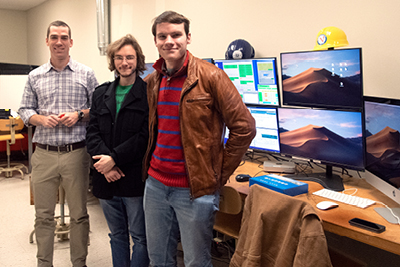 Menu
Menu

By Callie Ewing, BA ’03 MH ’22
In July, Peter Hedlesky, BS ’21, reaffirmed his acceptance to the Department of Defense (DOD) SMART Fellowship program. Hedlesky is spending this summer interning with the Air Force Research Laboratory (AFRL) at Kirtland Air Force Base in Albuquerque, New Mexico. He was selected to participate in the Space Scholars Program and support the Optical Frequency combs for Precision applications with mentors Robert Rockmore, Ph.D., and Sean Krzyzewski, Ph.D. The 12-week, onsite internship began on May 16 and will end on Aug. 5.
“This research opportunity seeks to replace conventional atomic clocks, like the one for NASA’s deep space atomic clock, with an integrated photonic circuit,” explained Hedlesky, who has been pursuing his doctorate in applied physics, with a focus in photonics, at Worcester Polytechnic Institute (WPI) since graduating from UD last year. “With Dr. Rockmore I am using COMSOL and Lumerical to design and fabricate a fully integrated optical clock. I also work with Dr. Krzyzewsk comparing my simulated clocks with ones in the lab.”
Timing is very important for Guidance, Navigation and Control (GNC), as GPS satellites can find your location by determining how much time it takes the signal from your phone to reach the satellite. The speed of light is then used to find the distance between you and four GPS satellites. The accuracy of GPS of seven meters is directly related to the 145-picosecond accuracy of the atomic clocks on each GPS satellite.
“The issue facing GPS is that these atomic clocks are expensive, both in price and weight,” explained Hedlesky. “A 14-pound atomic clock’s weight may seem trivial, but that weight adds around $47,434.50 per satellite in orbit. Our group at the Space Force seeks to replace these clocks with Integrated photonics chips (PICS) – think of a computer chip, but instead of electrons, photons are used. These PICS are small, a bit bigger than a grain of rice, require little power and are cheap to manufacture.”
Hedlesky added, “The fortunate thing is that a company I’ve worked with, Spark Photonics, is aiding in the development of the same silicon nitride design kit that the folks at Albuquerque are using. My work with Spark Photonics focused on developing a new material platform for PICs. When we develop a PIC, different materials are needed for different wavelengths of light, lasers and reducing attenuation. Silicon nitride is a great material platform for developing the PICs the group at the Space Force needs for their atomic clock replacements.”
The DOD SMART program is a fellowship that will fund the next four years of Hedlesky’s graduate program at WPI, also granting him an annual stipend. He will spend time each summer at the Defense Threat Reduction Agency (DTRA), learning what tools and methods they use to be on the left of a potential weapon of mass destruction (WMD) disaster.
“Being left of a WMD means that we have identified and neutralized a WMD before it can cause any harm,” explained Hedleskey. “As an applied physicist, I will be supporting the enlisted and commissioned members of the Armed Forces by developing the tools and training needed for them to successfully detect and deter a WMD.”
Once Hedlesky has completed his Ph.D. program, his DOD SMART service agreement mandates that he continue working for DTRA for four years after he graduates. After that, he may stay with DTRA or move to a different organization developing PICs for various applications. His interests primarily lie in chemical- and biological-sensing PICs or using PICs for light-based and quantum computation.
As an undergraduate at UD, Hedlesky worked with Affiliated Research Assistant Professor of Physics Will Flanagan, Ph.D., on developing the world’s smallest neutron detector.
“I believe it was the broad education at UD that really aided in my transfer from working on particle physics with Dr. Flanagan, to working on PICs for the Space Force, and now finally working with DTRA,” he said. “I not only had the opportunity to take nearly every physics class offered, but also to learn chemistry and business skills. I really must give my current interest in PICs to Dr. Catlett, whose physical chemistry class inspired my interest in semiconductors. Additionally, the soft skills I learned from UD’s Gupta College of Business will be critical for my time at DTRA, where I will be translating the needs of U.S. servicemen and women from the battlefield into technical solutions.”
However, Hedlesky is most grateful to UD for what it did for his soul. “UD created a Catholic environment to nurture and strengthen my faith,” he said. “I became a stronger Catholic through learning about what the dogma of my faith is, why we as Catholics profess it, and then practicing that dogma.
“I did not plan on going to UD to become a rockstar physicist,” he admitted. “While I do believe my physics professors prepared me well for graduate school, it was WPI’s status as a prestigious R2 school that enabled me to be noticed by these programs. However, I would stress that our goal on this planet is not earthly success, although my time at UD certainly brought much of that, but salvation with God.”